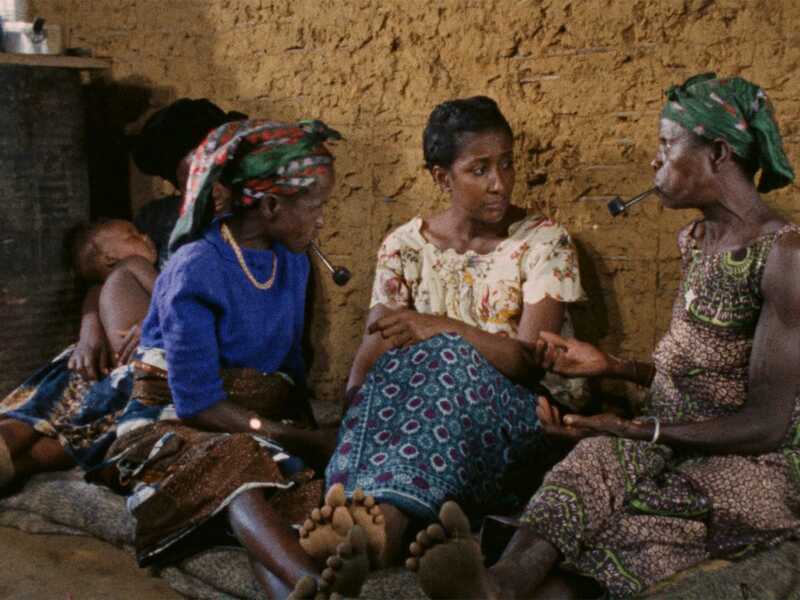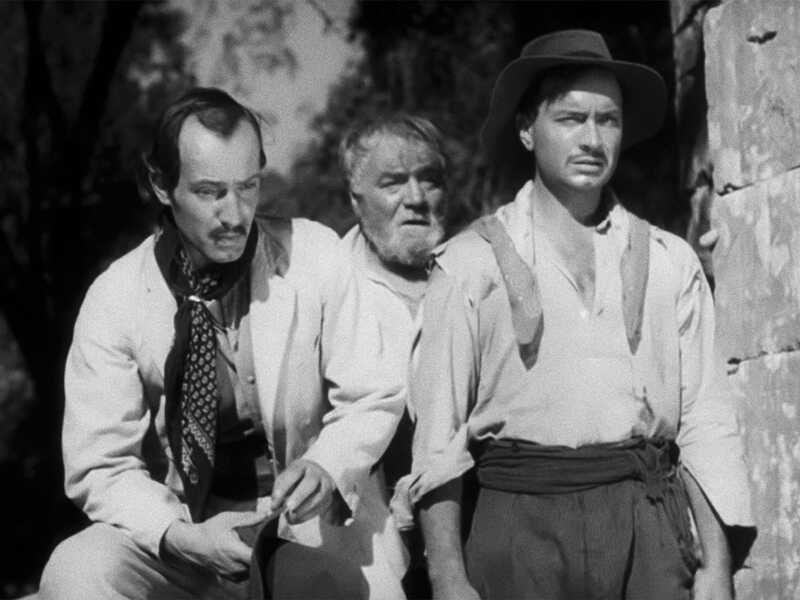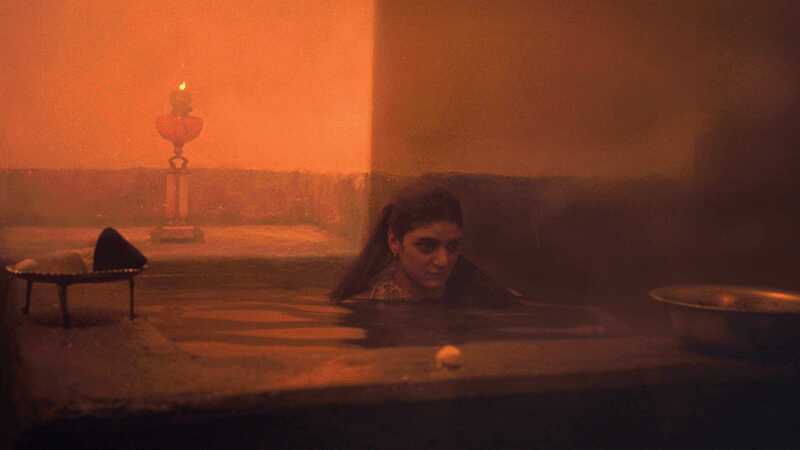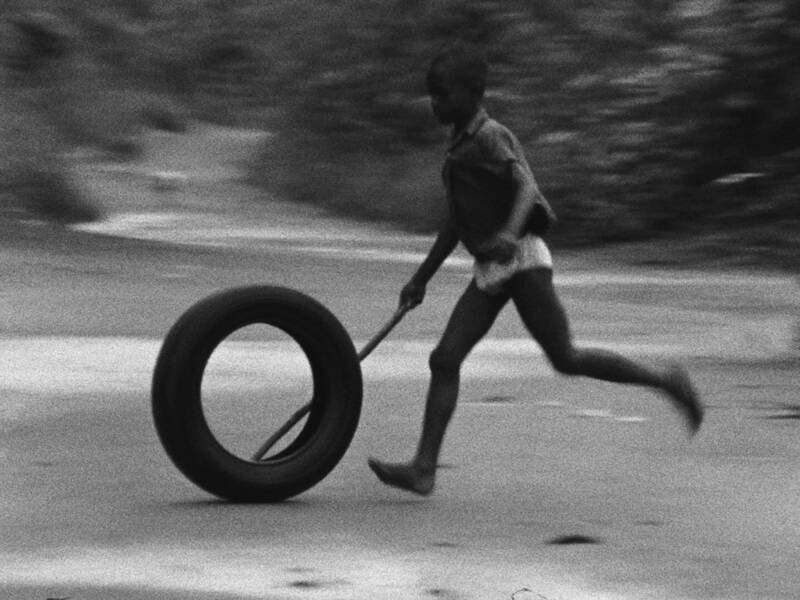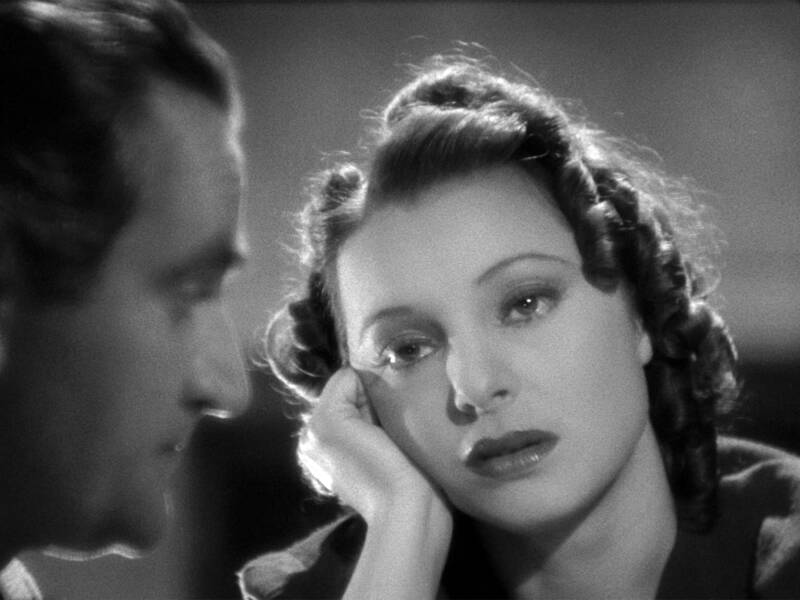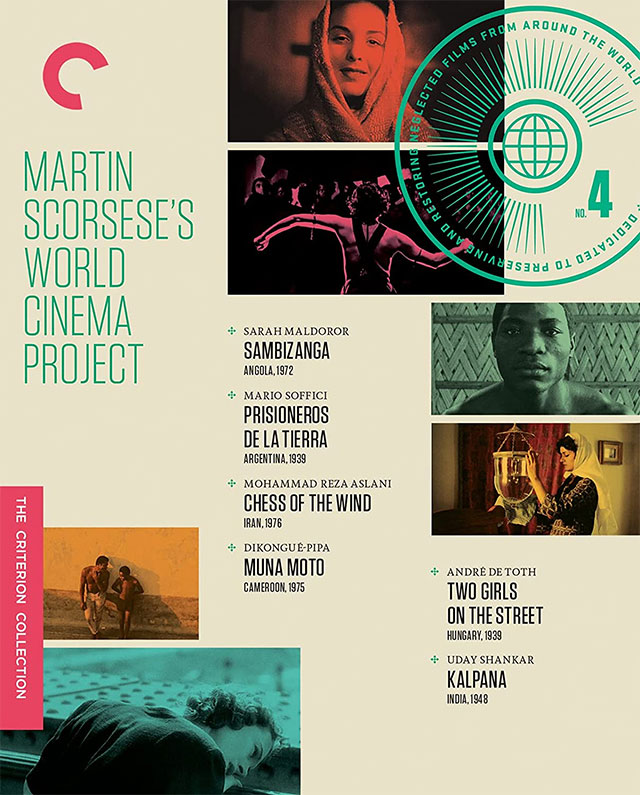
Blu-ray Review: Criterion Shepherds MARTIN SCORSESE'S WORLD CINEMA PROJECT NO. 4
Jim Tudor 12/27/2022Scorsese’s Film Foundation once again teams with Criterion for another round of newly restored films of global significance.
Though the often cinematically verbose Martin Scorsese has far less to say on his video introductions for the half-dozen films packaged together for this fourth edition of his “World Cinema Project,” the selected titles, as always, remain noteworthy.
Several are even vital. Released as a sturdy box set from Criterion to visually match the company’s previous three (and continuing to carry on as the last bastion of Criterion’s long ago abandoned dual-format packaging, including DVDs and Blu-rays of all the content), Scorsese’s Film Foundation has once again heroically gone forth and saved six historically prominent global titles from the ravages of poverty and/or neglect.
At least one director familiar to classic Hollywood film buffs makes the cut this time, as well as a female filmmaker, something particularly rare amid the often very limited filmmaking opportunities in undeveloped countries. Curiously, this WCP batch hails almost entirely from either the mid-to-early 1970s, or the very specific (and cinematically celebrated) year of 1939. The roundup for Volume Four breaks down thusly:
Sambizanga (Angola, Sarah Maldoror, 1972)
Prisioneros de la tierra (Argentina, Mario Soffici, 1939)
Chess of the Wind (Iran, Mohammad Reza Aslani, 1976)
Muna moto (Cameroon, Dikongué-Pipa, 1975)
Two Girls on the Street (Hungary, André de Toth, 1939)
Kalpana (India, Uday Shankar, 1948).
Below, we take more detailed looks at each of the films, as presented…
Sambizanga
Bereft with traumatic anguish over her disappeared husband, Maria (Elisa Andrade) collapses in the home of her trusted confidants. Immediately, one of the women takes her baby boy off her back and swift ushers him onto her breast.
The oppressed people of Angola (at the hands of Portuguese rule) may not have much, but they do have each other within their exceptionally tight knit community. Like any good community, it’s worth fighting for. In the case of Sambizanga, it is named after the area in Luanda where the real revolution began.
That fight broke out in 1961, spurred on by the kind of inhumane treatment witnessed in Sambizanga (1972), which took place just prior to that. In lieu of an organized rebellion (or as it’s referred to by the characters in hushed tones, “The Movement”), Maria is left to desperately scurry around asking about “her man.”
Despite the misleading current descriptions of Sambizanga on sites like IMDb and Wikipedia, the film is not about an imprisoned man valiantly resisting interrogation. That’s part of it, but truly, Sambizanga is a strong woman’s story… as only a strong woman could tell.
The late filmmaker Sarah Maldoror of Sambizanga is regarded and remembered today as one of Africa’s first women to direct a feature film. Her well-travelled life would take her to France and Russia and to the post of assistant director to director Gillo Pontecorvo on his revolutionary potent classic, The Battle of Algiers (1966).
Maldoror would know a thing or two about revolution and would harbor the attitudes to match. But, according to her daughter and not attested to by Sambizanga and her other films, it was poetry, not battle, that defined Maldoror’s artistic soul.
This and many other rare facts are gathered into Criterion’s bonus featurette, On Sambizanga: The Passion and Poetry of Sarah Maldoror (26:00). On it, the filmmaker’s daughter, Annouchka de Andrade, in English, details her mother’s colorful life, career, and philosophies. The featurette also contains subtitled interview footage with Maldoror from 2008.
Maldoror shoots Sambizanga with a universal urgency in a deeply localized Angolan village milieu. (Much of the cast is comprised of non-actors involved with African anti-colonial movements). Filmed in the comparatively less volatile land next door, the People’s Republic of Congo, Sambizanga is written by her husband Mário Coelho Pinto de Andrade, adapted from José Luandino Vieira’s novella.
There’s a powerful scrappiness about the film, heightened by the bright rigidity of the color palette that is all the more impressive thanks to this restoration by The Film Foundation’s World Cinema Project and Cineteca di Bologna at L’Image Retrouvée in association with Éditions René Chateau and the family of Sarah Maldoror.
Prisioneros de la tierra
The opening crawl reads, “Misiones is a breathtaking region in the far north of Argentina with magical charm, endless jungles and deep rivers. There the call to peace and work resounds ever more loudly, but it wasn’t always so… Many years ago men marked by destiny trod the crisscrossing trails of red death blazed by machete in the very heart of the jungle, in a saga of blood and alcohol. Our story takes us back to those strange and turbulent times.”
In a most remote location of Posadas during the troubled time of 1915, workers not only struggled to get by, they literally often struggled to stay alive. Director Mario Soffici’s heavily restored 1939 Argentine classic Prisioneros de la tierra (Prisoners of the Land) forecasts John Huston’s The Treasure of the Sierra Madre insofar as it begins with something of a Western spirit before shifting to something very different.
Although in this case, the shift is felt much sooner, as the exploitation of the many uneducated working class characters, or Mensú, becomes quickly apparent. (Clouzot’s The Wages of Fear comes to mind).
Although the central ideological clash between a particular targeted outspoken oppressed worker (Angel Magaña) and unrelenting boss (Francisco Petrone) plays out in Prisioneros de la tierra as it does in many other social justice-minded movies, right down to shared affection for a woman (Elisa Galvé) heightening and representing the conflict, Soffici goes about it differently. At numerous turns, established sympathies are subverted by simple human nature of the characters.
Soffici’s master stroke may just be in the moment when the repulsively suave villain is receiving comeuppance. For just a few moments during his prolonged torture and degradation, we catch ourselves feeling sorry for him. Or is it simply lament for the release of pent up “Dark Side energy” that our hero is suddenly giving off?
The jungle and its heat make everyone sick and crazy. The sad camp doctor, perpetually drunk on cashaça, may wish to be equated with his impressively unbreakable cane, but is increasingly consumed by his failures. He proclaims that in this terrible place, death is the same as life. Yet, he has no idea just how bad it can get…
A towering, humanist achievement in the history of Argentine cinema, Prisioneros de la tierra has been painstakingly restored to its original 1939 luster and running time. On the short featurette on the process, which was shepherded by Argentine film historians Paula Félix-Didier and Andrés Levinson, the pair discuss just how weathered, worn, and incomplete the film has been until their work was completed in 2019.
For many decades prior, there simply was no viably complete version of Prisioneros de la tierra (“Prisoners of the Earth”, or “Prisoners of the Land”). We are tremendously fortunate to now have this stirring, entertaining, and impactful film readily available and looking pretty remarkable.
Chess of the Wind
Looking more Visconti than Kiarostami with moments resonating as more Lynch than Panahi, director Mohammad Reza Aslani shatters a great many common perceptions of what Iranian cinema is/was. Chess of the Wind (aka, The Chess Game of the Wind; Shatranj-e Baad) came out in 1976 only to disappear amid fervor of its political controversy and predictable courting of certain outrage. Once the Iranian Revolution occurred in 1979, Chess of the Wind was written off as officially gone.
After its negative was discovered in an antique shop in 2015 and the subsequent restoration resurfacing to triumphant acclaim in 2020, however, it’s found its way into Martin Scorsese’s World Cinema Project No. 4. Thanks to the generous funding of the Hobson/Lucas Family Foundation, this, as well as most if not all the other endangered films in WCP4, is now back to its intended glory.
Inspired by filmmaker Max Ophüls in general and Stanley Kubrick’s Barry Lyndon in spirit, this first of only two narrative features made by documentarian Aslani exudes his trademark ornate visual lavishness throughout. Housebound in an impressively ornate old-world mansion, Chess of the Wind becomes a distinctly sharp, shattering portrait of a family heading towards a violent reckoning.
It’s the turbulent 1920s, as the slipping feudal system is giving way to modernity. The familial power struggle that erupts within this particular home, depicted often with limited, stylized color and a baroque kind of detachment from the type of tactile reality/realism so commonly associated with Iranian cinema, is analogous to broader Iran not only then but at the time of the film’s would-be release.
Chess of the Wind lands the single longest supplemental feature for any film in WCP4. Mohammad Reza Aslani’s daughter Gita Aslani Shahrestani’s fifty-one-minute documentary The Majnoun and the Wind (2022) is a heartfelt if rudimentary investigation into the history of her father’s cloistered masterpiece, and its very recent resurrection.
Aslani, still a sharp and communicative old man at the time of this filming (and this writing), is prominently featured, recalling the 1970s blow-by-blow systemic takedown of Chess of the Wind, as well as his initial skepticism at the notion of its restoration. Made at least in part during the COVID-19 lockdown era, several of the interviews, including members of the film’s cast and crew, and others, are conducted online.
Film critic and festival programmer Hossein Eidizadeh wrote that Chess of the Wind is “truly the Holy Grail of Iranian cinephiles – and a mesmerizing one.” All things considered, it’s pretty amazing how well this film now looks and sounds. (The jazzy, transfixing score by the prolific Sheida Gharachedaghi comes through exceptionally well). With nary a hair pinned dirt road nor village rubble in sight, Aslani’s recovered contemporary classic dares to buck the political and moral strictures of Iran.
Though not explicitly acted upon, Chess of the Wind also exhibits surprisingly sexual currents, particularly in its meticulously restored final portion, which is made to play like a tinted nightmarish silent film from the early, uncertain days of cinema. In both its meta story and its story proper, Aslani’s film serves as a potent, sometimes terse, warning about the tragedies and senselessness of domineering oppression.
Muna moto
Ngando’s uncle is on the make. His four wives aren’t providing the all-important offspring that they’re cultural tradition demands. “Witches,” he calls them. But this is no supernaturally tinged movie. Nor is it the “delicate love story” or “the African Romeo and Juliet,” as some refer to it.
No, Muna moto (The Child of Another) is a nuanced tale of a clash of values between Ngando (David Endene) and his uncle Mbongo (Abia Moukoko) in contemporary (1976) Douala, Cameroon. That, it not so coincidentally happens, is also the hometown of the director, Jean-Pierre Dikongué Pipa.
Douala, as portrayed here in soft greyscale, is a strained village that can’t or won’t navigate its way into the modern world. Dikongué Pipa very obviously has deep issues with this, seeing how he (in a foul mood) couldn’t not make this movie.
The question of “to what degree do we allow tradition and ritual to govern our lives as the world moves forward?” is one that’s been kicked around the world over. (Look no further than Rodgers & Hammerstein’s Flower Drum Song for a wildly different styled exploration). Here though, it feels raw. It feels personal.
Ngando and Ndomé (Arlette Din Bell) are in love. He is young and strapping, his spirit not yet overtaken by scars as his body is on its way to being. She is sensual, outgoing, and, most importantly to those looking to maximize her perceived “value” as a bride, she is a virgin. Because of this, Ngando cannot afford the payment that is traditionally made to her family.
Meanwhile, Ngando’s uncle has inherited all the wealth of our protagonist’s deceased father. The injustice that enables Ngando’s uncle to actively work against him broils just beneath the surface, barely contained. Dikongué Pipa himself, in a new video featurette (by filmmaker Mohamed Challouf and also featuring African film historian Férid Boughedir), explains that this anger was indeed his own. And yet, he’s claimed that maybe only one-fifth of what he truly felt is conveyed in the film.
The faces all throughout Muna moto are some of the most expressive one could ever encounter. This adds to be film’s semi-baroque sensibility, it’s nonlinear narrative freely disjointed, opening with what is a much later sequence.
Even the English subtitling sometimes feels like it’s operating to the beat of a different drum, as sometimes swaths of dialogue go untranslated, and other times, we get a single line that seems more descriptive. But for the most part, the subtitles operate as usual. Inspired by the lofty likes of Buñuel and Bergman, perhaps it’s no surprise that Dikongué Pipa forged his otherwise real-world-based filmmaking aesthetic in the strikingly personal manner of untethered dreaming.
Two Girls on the Street
Amid the bluster and din of life in bustling urban Budapest, there lingers moments of fleeting tenderness throughout director André de Toth’s Two Girls on the Street (Két lány az utcán). For that, thank terrific casting, particularly of the title girls, Bella Bordy as the youthful and naïve Vica Torma and Mária Tasnádi Fekete as the older refined runaway Gyöngyi Kártély.
Adapted from a play by Tamás Emöd and Rezsö Török, this 1939 social realist drama stands as a fine if not at all masterful glimpse of the talent fermenting in the director’s chair. De Toth would go on to have a long, remarkable career helming many a fondly remembered crime (1953’s Crime Wave), Noir (1948’s Pitfall), and Western films (1950’s excellent The Gunfighter; 1959’s psychological Western Day of the Outlaw), as well as the title that Scorsese calls the best 3-D movie ever made, 1953’s House of Wax.
One of only five early features that de Toth would make in his native Hungary, Two Girls on the Street resides in the “just fine” but not at all “great” category. Perhaps its most outwardly distinct calling card is its heavy use of location photography, serving up a vivid look at the Thirteenth District of Budapest.
The 2K digital restoration of the film wonderfully captures that certain dreamy haze of such silver-tinged monochromatic movies of the time. This alluring aesthetic both compliments and contrasts the shifting plights of Gyöngyi and Vica as they navigate their way from disparate poverty to luxury. All the while, they must bob, weave, and second-guess lecherous come-ons, gentlemanly courting, and their own amorphous bond, sometimes resembling a mother/daughter relationship, other times as competitors for certain male affection, and other times leaning towards lovers.
Besides the standard introduction by Scorsese, the title’s supplements include eleven minutes of footage of an elderly de Toth giving an inspirational talk to a very receptive audience. “You don’t direct the films,” he tells them. “The characters direct the films. Each has their own rhythms.” By that rationale, the director indeed directs, insofar as s/he must be attuned to those rhythms.
With the energetically charged and almost anthological Two Girls on the Street, de Toth demonstrates this skill even as he tilts wildly close towards Hollywood melodrama. Fortunately, that’s never a bad thing, although it does tend to fly in the face of the ascribed “social realism” component of the film.
Scorsese refers to de Toth as a “director’s director,” this being early evidence of his brisk and sometimes bold storytelling talent. The social commentary component, however, either takes a backseat or emerges periodically on the business end of a messaging sledgehammer. Still, for all it adds up to, Two Girls on the Street serves as somewhat of a reprieve from the ardently political bellringing that otherwise tend to fuel World Cinema Projectentries.
Kalpana
“God, what’s happened?”, shouts a woman in the final minutes of Uday Shankar’s dance-driven Kalpana. Honestly, I couldn’t begin to tell you.
The newly produced twenty-three-minute Criterion featurette, “On Kalpana”, offers some clarification, thanks to Indian film historians Kamar Shahani and Suresh Chabria. They point out how a key sequence of browbeaten factory workers plays like something out of Fritz Lang’s Metropolis or Charlie Chaplin’s Modern Times. And, they’re not at all wrong.
Those films make points of propping up their auteurs and their large, uncompromising auteurist visions via demonstrating the deadening factory life of the proletariat. The odd, weird, dark thumping surge that is Kalpana, while not on the level of prime Lang or Chaplin, nonetheless delivers spectacle to pronounced humanist ends.
The opening text scroll of this film invites us to join the filmmaker’s pursuit to make India great again. Those aren’t the exact words, but all those words are there. So immediately, Shankar’s Kalpana might unintentionally strike western viewers as something more twisted than what it is.
But then again, Kalpana, being a thoroughly odd, pulsating, warped journey of monochromatic dance fantasy, is plenty distorted on its own without sounding a dog whistle for fed-up toxic nationalists. Uday Shankar (musician Ravi Shankar’s brother, starring alongside his wife, Amala Shankar, in their only feature film outing) seems quite genuine in his own stated intentions of his homeland’s betterment.
This dreamlike panoply of performance and passion is a feverish experience that’s not like the other movies. As in, any other movies. Although the plot reflects Shankar’s own true-life quest to open a cultural arts center in India, many of the strangely stagey and oddly ornate dance sequences that make up the film are rooted in Hindi mythology.
The prominently featured Shankars themselves dance like nobody’s business, although their bizarrely contorted facial expressions prove inadvertently distracting. Many dancers seem to harbor two expressions, “needing to go to the bathroom” and “going to the bathroom.” As for our main protagonist, if he is going to be a great dancer, he must learn of Taal, the rhythm of the universe. So that’s part of this, too.
Clocking in around two and a half hours, Kalpana proves to be at once entrancing and a bit interminable. The routines are sometimes characters’ dreams, and sometimes simply the narrative mode of integrated dance that occurs in most musicals.
Restored in 2012 from existing film elements from the National Film Archive of India, Kalpana’s black and white cinematography has a dreamy kind of smudginess about it. It resembles nothing else, particularly when it frequently lapses into old world costumed dance numbers. The near-constant drumming, though, becomes lulling. Caffeinate accordingly.
*****
While World Cinema Project No. 4 stands as another fully commendable and impressive effort of otherwise unlikely film preservation -- some of the titles, such as Kalpana and Chess of the Wind, were frighteningly close to becoming lost forever -- the actual boots-on-the-ground review effort of getting through all six of these titles as a collection proved more difficult than the previous box sets. At times, I was utterly defeated by the process. It’s impossible for me to know why that is. I can say, however, that the burden lie entirely on me, and the experience simply wasn’t taking like it had in the past.
None of that is to besmirch the solidity and vitality of these individual titles, nor their filmmakers or appreciators. World Cinema Project No. 4, for all the important effort and resources that went into it as well as the disparate batch of films themselves, is a recommended purchase.
Rushing through it, however, might not be the way to proper experience it. This is more of an aged wine, recovered from the forgotten corners of the world, and uncorked to be appreciated over time.
*****
The official Criterion Collection list of supplements, set features, and points of interest for Martin Scorsese’s World Cinema Project 4:
DUAL-FORMAT BLU-RAY AND DVD SPECIAL EDITION FEATURES
• New 4K digital restorations of Sambizanga, Prisioneros de la tierra, Chess of the Wind, and Muna moto, and 2K digital restorations of Two Girls on the Street and Kalpana, all overseen by The Film Foundation’s World Cinema Project in collaboration with the Cineteca di Bologna, with uncompressed monaural soundtracks on the Blu-rays
• New introductions to the films by World Cinema Project founder Martin Scorsese
• New and archival interviews featuring Indian film historian Suresh Chabria and filmmaker Kumar Shahani (on Kalpana); Argentine film historians Paula Félix-Didier and Andrés Levinson (on Prisioneros de la tierra); Two Girls on the Street director André de Toth; and Sambizanga director Sarah Maldoror and Annouchka de Andrade, Maldoror’s daughter
• New program by filmmaker Mohamed Challouf featuring interviews with Muna moto director Dikongué-Pipa and African film historian Férid Boughedir
• The Majnoun and the Wind (2022), a documentary by Gita Aslani Shahrestani, daughter of Chess of the Wind director Mohammad Reza Aslani, featuring Aslani, members of the film’s cast and crew, and others
• New and updated English subtitle translations
• PLUS: A foreword and essays on the films by critics and scholars Yasmina Price, Matthew Karush, Ehsan Khoshbakht, Aboubakar Sanogo, Chris Fujiwara, and Shai Heredia
ScreenAnarchy
